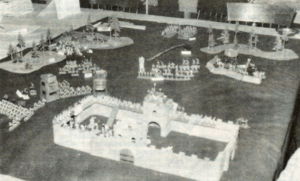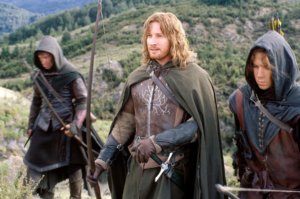In the last two posts we discussed mercenary troops from a modernist perspective. That is to say, how does using hirelings work when it comes to spending all those gp you grabbed for XP, and how does a Square One focus on building an army contribute to the overall narrative of a D&D campaign. Today, let’s look at hirelings from an Original Intent perspective.
And that begins with the critical ratio of 1:10.

Recall that Gary urged us to use one sergeant for every ten troops. If you use a figure:hireling ratio of 10:1, then each squad of troops on the payroll represents one figure. Captains (you must be 5-th level to ride this ride) enter the realm of 1:1, taking their place alongside PCs as worthy of that honor. This is where the use of LTs comes in handy. That 5th-level captain can only command 200 troops – or 20 figures – but if you swoop a few LTs (which may be counted among the block troops or as individual figures to suit your taste), then you can push that number to a cool 35 figures. Captain Nameless can boss around five LTs of 3rd-level, each of whom can command 30 troops of his own. That ain’t nothing.
Here’s where the ec0nomics get involved. You might just hire a second 5-th level Captain at 500gp instead of five 3rd-level LTs at 1,500gp. But now you’ve got two smaller units, which will suffer morale tests much faster. Units test morale at the 25% casualty mark, among other things. That means instead of the big unit testing after 9 fall, for example, an enemy can force half your army to test at the loss of just 5 figures.
We should circle back around to economics at this point as well. If you’re out in the wilds, those 5th-level fighters might be hard to find. You might have to settle for hiring a few lower-tier commanders while your headhunters (not literal) do some recruiting back in civilization.

Looking back at the wargame, you also have to consider how many different troop types you want in your army. Each troop type requires a captain of its own, which can get expensive fast. An extra 500gp just for adding a unit of crossbowmen to an army that already has long-range fire in the form of longbows? Is it really worth the added expense? Do you really want to spend 500gp for a Captain to command 30 light foot? Probably not. You’ll want to bulk out those light foot to at least 100 or more to make that initial expense worthwhile. You might have one unit of light horse and one of heavy, but rarely will you find an army with a nice balance of all three horse types. Most commonly, you’ll likely have nothing but medium horse as a compromise. And compromises are something every military leader has to live with.
Including your Fighting Man.
Fortunately, all of this should drive you toward building an order-of-battle that is useful in a wide range of situations using the minimum amount of fuss. Which is something every military leader has to do.
Including your Fighting Man.
More to the point, by the time you reach this level of planning, you should be thinking more like a military commander. You’re not thinking in terms of men, but squads and platoons – which we have simply renamed figures and units. The ratio lets you throw figures down on the table, but even if you play strict theater of the mind D&D, the little bit of work you do to prepare for battle will help you see the action in a whole new light.
You should start to see the action more as a commander of men and less as a Guy on Adventure. And that is a very special kind of magic.


Enjoying your AD&D content.